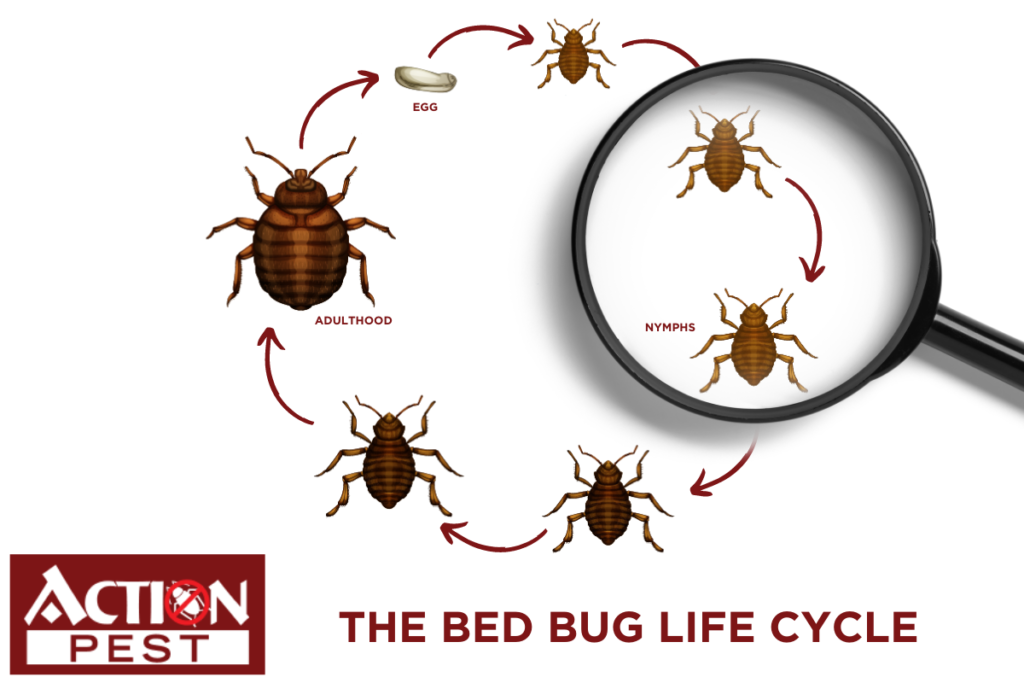
Bed bugs are tiny, wingless, nocturnal insects that can wreak quite a bit of havoc. However, if you’ve discovered a bed bug infestation early, it will be easier and cheaper to treat compared to a full-blown infestation. When dealing with a large infestation, patience is necessary to get rid of every trace. Well, you can’t get rid of them unless you know more about them. Today we’ll be discussing the different stages of the bed bug life cycle. During their lifetime, bed bugs will go through three main stages:
3 Main Stages of The Bed Bug Life Cycle
Stage 1: Eggs
The bed bug life cycle starts as a milky-white egg. An adult female bed bug only lays about 1 egg per day or 200-250 eggs within their lifetime. The eggs can be found either in clusters or one by one in tight cracks. It is roughly 1 mm long and its size is approximately two grains of salt. Bed bugs lay sticky eggs that adhere to surfaces. After 5 days, the eggs are marked by an eyespot and in two weeks they hatch, unleashing immature bed bugs that immediately start feeding. That leads us to the next stage.
Stage 2: Nymphs
Newly hatched nymphs are approximately the size of a pinhead and can be translucent. Nymphs or young bed bugs must shed their skins five times to become fully matured adults. During the bed bug life cycle, nymphs resemble adults. However, their size is smaller and they are not sexually mature. This means they can’t reproduce yet. Also, the colour of young nymphs is yellow-white whereas adults are a reddish-brown colour.
It is almost nearly impossible to detect nymphs that have not been fed recently because of their size and colour. To complete each stage in their lifecycle, each nymph needs a blood meal. It takes them five weeks to moult and room temperature for bed bugs to become fully grown adults.
Stage 3: Adulthood
An adult bed bug is approximately ¼ inch or 5 to 7 mm long with a flat and oval body. After reaching maturity, an adult bed bug usually feeds weekly to allow them to lay eggs. A bed bug’s life span varies from 4 to 6 months but some can live up to a year in cool conditions and without food.
Bed bugs can mature in a month under favourable conditions and supply of blood, allowing them to produce multiple generations within a single year.
Bed Bug Habits & Behaviour
Bed bugs are efficient hitchhikers which makes it easy to transport them into dwellings on furniture, clothing, belonging, and luggage. It is a common problem for hotels, homes, schools, shelters, dormitories, and apartments. As we mentioned before, bed bugs are wingless so the most efficient way for them to travel long distances is by climbing and attaching themselves to humans or pets.
Bed bugs are hardy insects with great endurance. Both adults and nymphs can survive months without food. They can even survive longer, up to a year, without food in cooler temperatures at 12⁰C or less. So, leaving home unoccupied with the hope of starving a bed bug infestation is usually impractical. Normally, bed bugs reduce their activity or disperse to the neighbouring units if an infested dwelling like an apartment is vacant.
Bed bugs have flat bodies that let them maneuver and hide in areas such as bed frames, upholstered furniture, floor cracks, and carpets. They are mainly active during the night or around dawn. During the day, bed bugs like to hide near where people sleep because they like to stay near their food source. However, when necessary, they will crawl long distances to look for food.
Bed Bug Infestations — What to Look Out For
Bed bugs tend to congregate in common hiding places such as mattresses, headboards, and box springs. Look for dark spots and stains which can be the excrement of bed bugs. Also, search for both hatched and unhatched eggs as well as tan-coloured skin that developing nymphs shed. Another sign is a reddish or rusty smear on mattresses or bed sheets as a result of crushing blood-engorged bed bugs.
Checking your body is also an easy way to discover bed bugs. Since bed bugs tend to feed on human blood, you may see rashes or welts on the body from being fed on. They’ll most likely feed on body parts not covered in clothing such as your neck, arms and legs.
Remedies for Bed Bug Infestations
Bed bugs are a challenge since they can hide in so many places. So, the best option is to hire professional bed bug exterminators. An experienced pest controller knows exactly where to look and has all the tools necessary to contain a bed bug infestation. But, there are many ways to rid your homes of them. Here are some of the popular remedies a pest control company may opt for:
Vacuuming, Steaming & Freezing: Vacuuming infested locations helps to remove some of the bugs before undertaking more treatment. Some professionals use commercial steamers or freezing equipment to treat areas that are more infested. The drastic temperature changes from steaming and freezing will help to exterminate them. Whereas vacuuming will remove them from the location.
Heat Treatments: Experienced pest control firms use special heating equipment to de-infest rooms, furnishings, and entire homes of bed bugs. It involves heating the infested area to lethal temperatures for the bugs. Be wary as this heat treatment can cause some damage to your furniture, for example, wooden doors warping from the excessive heat.
Insecticides: Most professionals use insecticides in the form of aerosol, dust, or liquid. Also, fumigation with a penetrating gas is another technique professionals use to de-bug furnishings or dwellings. After the bed bugs have been eradicated the pest control company will remove their bodies.
Tips to Avoid A Bed Bug Infestations
- Avoid second-hand items like sofas and mattresses.
- Run fabrics and clothes from yard sales through the dryer or washer before storing them.
- Pro-active surveillance in hotels and apartments.
- After returning home from places with a higher likelihood of bed bugs, keep your items seperate or tied up until you’ve thoroughly inspect and clean them.
Get Professional Help — Contact Action Pest Control
By the time you realize a bed bug infestation has occurred, it is probably too late for home remedies. To eliminate the unwanted insects with 100% guaranteed satisfaction, contact Action Pest as soon as possible. Action Pest has over 40 years of experience handling all types of pests and insects. Their prompt intervention will deal with all the stages of the bed bug life cycle using only state-of-the-art equipment. Confidentiality is also important to Action Pest, that’s why we discreetly arrive on time with unmarked vehicles. We’ll treat your home like it’s ours — visit Action Pest today for more details.







